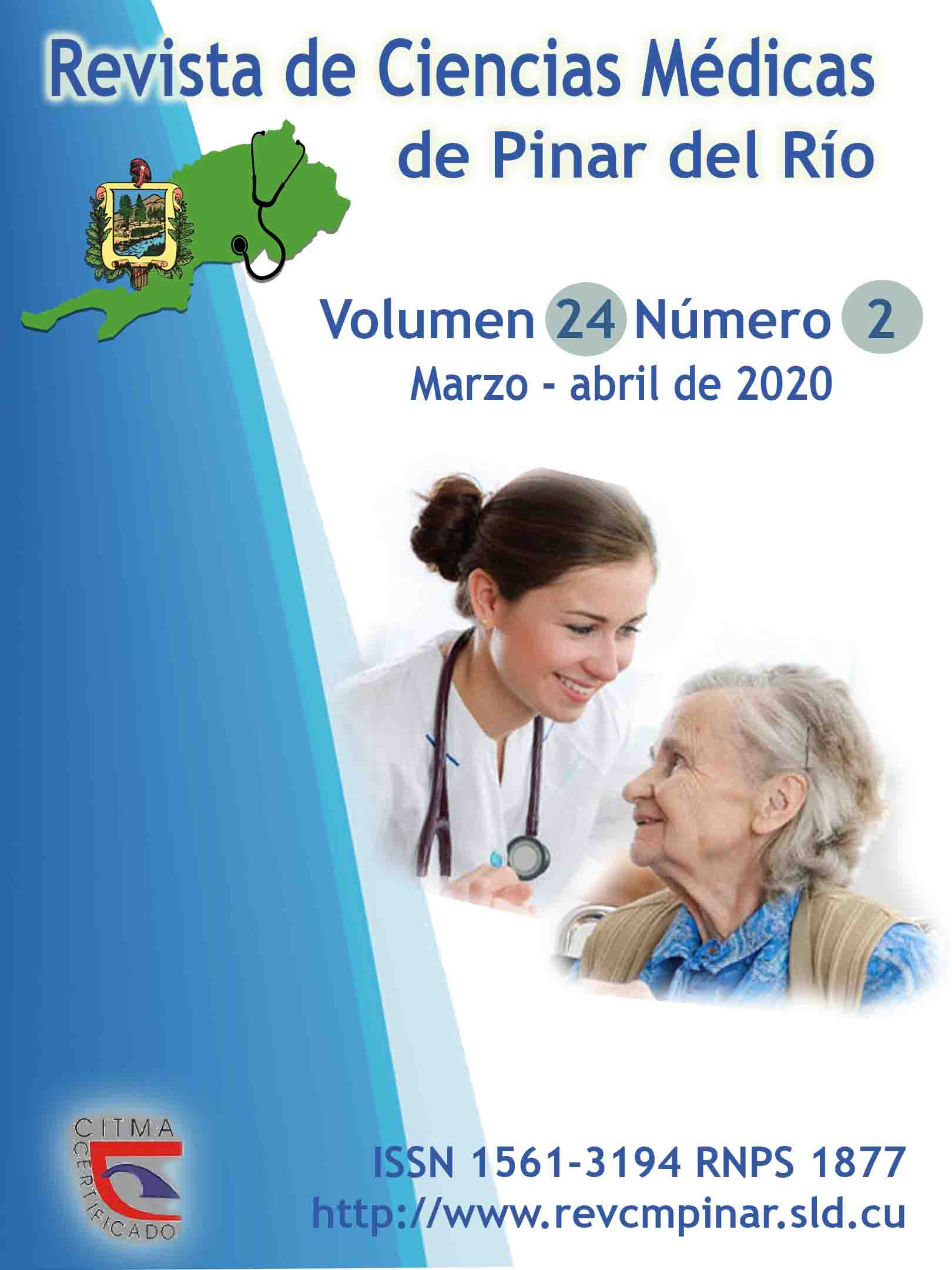Strategy for the improvement of the subject Elements of Qualitative Health Research in the Nursing Major
Keywords:
RESEARCH, QUALITATIVE RESEARCH, STRATEGIES, NURSING.Abstract
Introduction: medical education in the 21st century poses the need for a new teaching-learning process, based on the principles of excellence, quality and relevance. Therefore, this research proposes how to improve the teaching-learning process of the qualitative research so that it contributes to the performance of students in the Nursing major in accordance with the research function of the professional model.
Objective: to develop a didactic strategy for the improvement of the teaching-learning process of qualitative research in order to contribute to the performance of students in the Nursing major in accordance with the research function of the professional model.
Methods: observation and documentary analysis as an empirical method. Descriptive statistics was applied as a statistical method.
Results: the results of the evaluation of the experts, as indicators that define the strategic actions considered in order to be implemented in the strategy proposed, which demonstrates the agreement of the criteria of the chosen experts with the reviewed authors, where a great importance is attributed to the role of the qualitative research as the tool for the construction of nursing as a discipline and social profession.
Conclusions: this strategy contributes to the improvement of the instructional, educational and developmental aspects of the teaching-learning process, and at the same time it allows the insertion of research skills into the professional performance.
Downloads
References
1. Sucre González L, Cedeño González JA. Un recorrido al proceso de mediación, análisis y teorización en la investigación cualitativa. Revista Atlante: Cuadernos de Educación y Desarrollo [Internet]. 2019 [citado 10/11/2019]; 2019(9): [aprox. 10p]. Disponible en:
https://www.eumed.net/rev/atlante/2019/09/investigacion-cualitativa.html
2. Nieuwenhuis FJ. Martini Qualitative Research: Shaken, not Stirred. BCES Conference Proceedings [Internet]. 2015 [citado 10/11/2019]; 13(1): [aprox. 1p.]. Disponible en: https://eric.ed.gov/?id=ED568925
3. Daniel EK. The Usefulness of Qualitative and Quantitative Approaches and Methods in Researching Problem-Solving Ability in Science Education Curriculum. Journal of Education and Practice [Internet]. 2016 [citado 10/11/2019]; 7(15): [aprox. 9p.]. Disponible en: https://eric.ed.gov/?id=EJ1103224
4. Duncan C, Duff Cloutier J, Mossey Sh, Hill Bailey P. Teaching/Learning strategy for the preliminary critique of qualitative research. Journal of Nursing Education and Practice [Internet]. 2013 [citado 10/11/2019]; 3(1): [aprox. 5p.]. Disponible en: http://citeseerx.ist.psu.edu/viewdoc/download?doi=10.1.1.1033.3887&rep=rep1&type=pdf
5. Rizzo Parse R. What Families Want From Nurses. Nursing Science Quarterly [Internet]. 2017 [citado 10/11/2019]; 30(2): [aprox. 1p.]. Disponible en: https://journals.sagepub.com/doi/full/10.1177/0894318417693319
6. Cheng KKF, Clark AM. Qualitative Methods and Patient-Reported Outcomes: Measures Development and Adaptation. International Journal of Qualitative Methods [Internet]. 2017 [citado 10/11/2019]; 16(1). Disponible en: https://journals.sagepub.com/doi/full/10.1177/1609406917702983
7. Jiménez González A, Robles Zepeda FJ. Las estrategias didácticas y su papel en el desarrollo del proceso de enseñanza aprendizaje. Revista Educateconciencia [Internet]. Enero-Marzo; 2016 [citado 10/11/2019]; 9(10): [aprox. 7p.]. Disponible en: http://tecnocientifica.com.mx/educateconciencia/index.php/revistaeducate/article/download/16/142
8. Orellana Pérez VC, Colón Orellana IE, Perdomo Orellana EA, Pérez Núñez L. Estrategia educativa para fortalecer el valor responsabilidad en la carrera Licenciatura en Enfermería. Edumecentro [Internet]. 2015 [citado 10/11/2019]; 7(2): [aprox. 4p.]. Disponible en: http://www.revedumecentro.sld.cu/index.php/edumc/article/view/405/pdf_68
9. Marimón Carranza JA, Guelme Valdés EL. Aproximación a la estrategia como resultado científico. [documento digital]; 2010.
10. Peña Fernández JM, León Flores NM, Guillén Clemente CP, Vallejo Becerril TA. Propuesta de un modelo para el diseño de las estrategias como resultado científico en las investigaciones pedagógicas. SATHIRI [Internet]. 2018 [citado 10/11/2019]; 12(2): [aprox. 11p.]. Disponible en: http://revistasdigitales.upec.edu.ec/index.php/sathiri/article/view/122
11. Cruz Ramírez M. Un estudio sobre la implementación del método Delphi en publicaciones de ciencias médicas indexadas en Scopus. Educ Med Super [Internet]. 2018 Sep [citado 10/05/2019]; 32(3): [aprox. 14p.]. Disponible en: http://scielo.sld.cu/scielo.php?script=sci_arttext&pid=S0864-21412018000300003&lng=es
12. Bermudez Camps IB, Téllez López AM, López Orozco M, García Pérez ME, Flores Mera JF, Reyes Hernández I. Validación por método Delphi de indicadores de calidad para evaluar un servicio de educación sanitaria. Revista Cubana de Farmacia [Internet]. 2018 [citado 20/11/2019]; 52(1): [aprox. 10p]. Disponible en: http://www.revfarmacia.sld.cu/index.php/far/article/view/205
13. Medina Macias A. Diseño y validación de un programa de formación de competencia para la gestión eficaz de la seguridad y salud en el trabajo. Katarsis [Internet]. 2019 [citado 21/11/2019]; 28(2): [aprox. 6p]. Disponible en: https://dialnet.unirioja.es/descarga/articulo/7101951.pdf
14. Legañoa Alonso J, Soler Herrera M, Souto Nápoles Y, Rodríguez Ramos S. Perfeccionamiento de la asignatura Atención Integral a la Población en la carrera de Estomatología. Humanidades Médicas [Internet]. 2019 [citado 25/11/2019]; 19(2): [aprox. 18p.]. Disponible en: http://humanidadesmedicas.sld.cu/index.php/hm/article/view/1358
Downloads
Published
How to Cite
Issue
Section
License
Authors who have publications with this journal agree to the following terms: Authors will retain their copyrights and grant the journal the right of first publication of their work, which will be publication of their work, which will be simultaneously subject to the Creative Commons Attribution License (CC-BY-NC 4.0) that allows third parties to share the work as long as its author and first publication in this journal are indicated.
Authors may adopt other non-exclusive license agreements for distribution of the published version of the work (e.g.: deposit it in an institutional telematic archive or publish it in a volume). Likewise, and according to the recommendations of the Medical Sciences Editorial (ECIMED), authors must declare in each article their contribution according to the CRediT taxonomy (contributor roles). This taxonomy includes 14 roles, which can be used to represent the tasks typically performed by contributors in scientific academic production. It should be consulted in monograph) whenever initial publication in this journal is indicated. Authors are allowed and encouraged to disseminate their work through the Internet (e.g., in institutional telematic archives or on their web page) before and during the submission process, which may produce interesting exchanges and increase citations of the published work. (See The effect of open access). https://casrai.org/credit/



